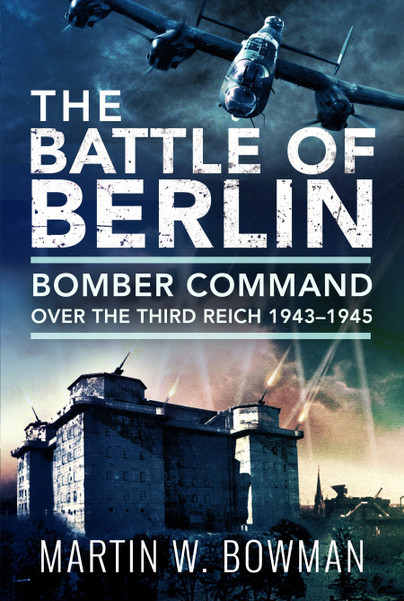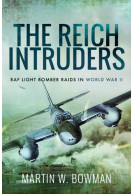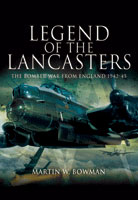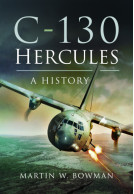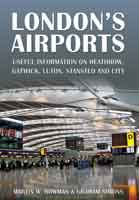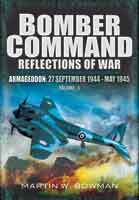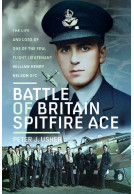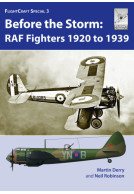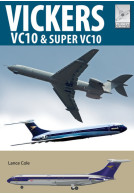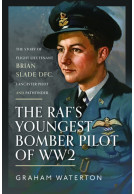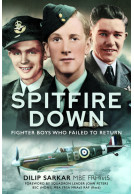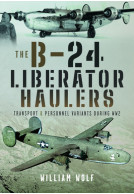Battle of Berlin (Hardback)
Bomber Command over the Third Reich, 1943–1945
Imprint: Air World
Pages: 456
Illustrations: 32 black and white
ISBN: 9781526786388
Published: 28th July 2020
(click here for international delivery rates)
Need a currency converter? Check XE.com for live rates
| Other formats available - Buy the Hardback and get the eBook for £1.99! | Price |
|---|---|
| Battle of Berlin ePub (10.1 MB) Add to Basket | £6.99 |
The Battle of Berlin, the bombing of the ‘Big City’ as it was known to the crews of RAF Bomber Command, raged from 18 November 1943 to the end of the war in Europe in 1945. It is recalled here both by those in the air over capital of the Third Reich, as well as those who suffered under the bombing onslaught.
At the start of the Battle of Berlin, Sir Arthur Harris had predicted that the ‘Big City’ would ‘cost between 400-500 aircraft’, but that it would also ‘cost Germany the war’. He was proved wrong on both counts. Berlin was not ‘wrecked from end to end’, as Harris predicted on 3 November 1943 – ‘if the USAAF will come in on it’ – although a considerable part of it was destroyed. And the ‘Main Battle of Berlin’ did not cost Germany the war; a grinding land campaign had yet to be fought. More than 9,000 bombing sorties were flown during the battle on round trips of about 1,200 miles to Berlin and back.
Berlin was bombed by four Allied air forces between 1940 and 1945. British bombers alone dropped 45,517 tons of bombs, whilst the Americans a further 23,000 tons. By 1944, some 1.2 million people, 790,000 of them women and children, about a quarter of Berlin’s population, had been evacuated to rural areas. An effort was made to evacuate all children from Berlin, but this was defeated by parents and many evacuees who soon made their way back to the city. However, by May 1945, 1.7 million people – 40% of the population – had fled the city.
This fitting tribute to those who died in the relentless struggle to knock Berlin, and hopefully Germany, out of the war resonates with eye-witness accounts and background information which the author has painstakingly investigated and researched. The result is a hugely fascinating and highly readable narrative containing very real and unique observations by British and Commonwealth aircrew and, equally importantly, the long-suffering citizens of Berlin, and well as the capital’s defenders.
Up to the end of March 1945, there had been a total of 314 air raids on Berlin, eighty-five of these in the last twelve months. Estimates of the total number of dead in Berlin from air raids range from 20,000 to 50,000; the relatively low casualty figure in Berlin is partly the result of the city’s formidable air defences and shelters.
The Battle of Berlin was not a defeat in absolute terms, but in the operational sense it was an offensive that Air Marshal Sir Arthur Harris and his aircrews could not win. ‘Berlin won’ concluded Sir Ralph Cochrane, the Air Officer Commanding 5 Group RAF Bomber Command. ‘It was just too tough a nut.’
As featured on World War II Today
WW2 Today
"Unquestionably, the volume of research necessary to amass this amount of first-person material is impressive. For someone interested in
Air & Space Power History, Autumn 2022
war stories and personal accounts, Bowman is a good
source."
This book is a thoroughly well researched project into the, mainly, bombing and aerial activities during WWII, especially of the bombing of Berlin from November 1943 to the war’s end in 1945.
Dr Adrian Greaves, The Anglo-Zulu War Historical Society
The book is an excellent chronology of the campaign and clearly details the units and airman involved with illuminating personal insights from pilots and civilians involved, and including experiences of the ‘other side’. Some 9,000 allied bombing sorties were carried out during this period with the British dropping some 45,000 tons of bombs on the city in support of American raids which dropped a further 23,000 tons. By the war’s end some 1.7 million people had fled Berlin, mainly women and children, to avoid the incessant bombing – and at the war’s end to distance themselves from the approaching Russian army – this exodus amounted to about 40% of the population. Of course, at that point in time, such warfare was then necessary and the role of Sir Arthur Harris is fairly considered by the author.
Having served in Berlin in the early 1960s I saw much of the bomb damage and the results which could then still be seen across the city, along with the growing man-made mountain of rubble to the south of the city. Today Berlin is a fine city with little trace of the war. The east side of the city, occupied by the Russians until the fall of the Berlin wall, has also now been rebuilt to a similar quality to that seen in the west.
This book is both informative and gripping. I found it difficult to put down as each chapter draws you compellingly to the next.
Highly commended.
As featured in
The Armourer
"...eloquently describes the unbelievable ferocity of bombing, the RAF relentlessly day by day, the USAF relentlessly night after night, that promised total destruction of the city beyond gravel."
ARGunners.com
Review by Geoff Simpson
Railway & Canal Historical Society, Air Transport Group
Bowman is a prolific aviation author and he has produced an atmospheric book packed with detail, covering both sides of the story. He has done a service to researchers, though perhaps there is too much detail for those with merely a passing interest.
This book has been a difficult one to review. It meets its aims and is meticulously researched, something for which the author is noted, The book lists, over 20 Chapters, the course of the campaign, the effect on the aircrews and to a lesser degree, the effect on the occupants of Berlin. It does not make comfortable reading. The author chooses to use anecdotes and personal histories, with personality portraits to tell the story of the campaign, rather than a drier operational analysis style of writing.
Chris Kemp
It can be read by dipping into chapters, providing a slightly surreal “ripping yarn sense” of the campaign, with ENSA parties and japes in the mess, but is probably best read in long stretches, where the sense of unending repetitive stress builds into a feeling of dread, as crews wonder if they will be the ones not coming back tonight.
The author touches on the controversies of the strategic bombing campaign, but mainly offers the viewpoint of the crews undertaking the bombing. The industrial process nature of the campaign is brought out well, with mention of the damage that the campaign did to German war industries. The question of the effect that the campaign had on diversion of German resources into fighter and antiaircraft defence is also covered.
This book is a fitting tribute to the many bomber crews that fought and died during the campaign and accurately conveys their viewpoint and gives a flavour of their experience.
As featured onArmy Rumour Service
Army Rumour Service (ARRSE)
An impressively informative, deftly written, exceptionally well documented, and expertly organized history, "Battle of Berlin: Bomber Command over the Third Reich, 1943 - 1945" is a seminal work of original scholarship and one that is especially and unreservedly recommended for both community and college/university library World War II European Theatre collections in general, and WWII aerial warfare supplemental studies lists in particular.
Midwest Book Review
Sir Arthur Travis ‘Bomber’ Harris basically ran Bomber Command with a passion, he always believed the best way was to go big against Nazi Germany. The book follows the number and organisation of what turned out to be thousands of bombing raids over Berlin and the surrounding area. Although 40% of the population leaves the city, not as much of the city ended up being destroyed, especially when you consider how much was dropped on it. It turned out Germany had its own Blitz spirit too. This book contains a fascinating look into the aircrews used and the effect on those who had to live through this constant bombing. The research and insights throughout this book are both splendid and exhausting. A definitive book and comprehensive read by an excellent author and historian in Martin Bowman.
UK Historian
As I’ve said previously any book written by Martin Bowman is a fantastic writer and historian, because he really does know his stuff which is why he has huge WWII portfolio of books. The research and writing is second to none, and I would say that this is born out on the back cover from a number of reviews from equally good historians. You learn an awful lot from this book and stuff I hadn’t known about before. I really enjoyed how the author went into so much detail not just about the people but also the daily flights and missions, you learn so much about the personnel it can sometimes be a lot to take in. This is a phenomenal book on the subject, certainly one I’d want on my shelf, this is a definite one to get. I give this a 5 star rating.
Read the full review here
This was an interesting book to read, and very informative. I learned a lot from this book. I do recommend it if you want to know more about WWII.
NetGalley, Linde Boon
I learned a lot about the RAF bombing missions over occupied Europe. I had not read before of USAF airmen serving aboard RAF planes. Nor had I been aware of the use of 'sky markers' and 'route markers'. I do like the selected cover art. I give this book a 4 out of 5.
NetGalley, John Purvis
Rating: 5 out of 5 stars
NetGalley, Peter Coxall
The Battle of Berlin rates as one of the finest books that I have read on RAF Bomber Command during WW2. It concentrates on the major bombing operations against Berlin and their impact on a wide spectrum of participants. .
I really appreciated the fact that the author covered the bombing raids from many perspectives, the RAF aircrew and groundcrew, German Luftwaffe pilots, civilians on the ground in Germany and the UK, a number of senior Nazi leaders, aircrew families etc. There are many powerful and emotional, individual stories covered in the book. Clearly the author has undertaken a vast amount of research.
The young aircrews endured terrifying missions on a regular basis, knowing full well that the odds were stacked against them to complete the required tour of 30 operations. Their life expectancy was appallingly short, the book mentions six weeks for novice crews. There were many ways of dying, all of them appallingly unpleasant. The stoic bravery they displayed must never be forgotten. We must also not forget the courageous role played by Stirling and Halifax aircrews, who had a much higher chance of being shot down than the Lancaster bombers.
I was previously unaware that the British regularly broadcasted fake messages, in perfect German, to confuse Luftwaffe night fighter crews. Long Hitler speeches were also read out over the frequencies used by the German pilots. British dirty-tricks at their best!
My only slight complaint about the book is that my parents weren’t mentioned! My Father flew on a number of these raids with 57 Squadron, one of which was almost his last. My Mother was a WAAF in the Intelligence section at RAF Scampton. Luckily, they both survived the war otherwise I would not be writing this review.
This is a most comprehensive and detailed account of the many attempts by Bomber Command in their ultimately unsuccessful efforts to assert such dominance over the capital city of the German Reich during World War 2 that Germany would not be prepared to continue the war. Many readers who are likely to be interested in this title will already have more than a passing knowledge of the role that Bomber Command played in the Second World War, and the evolution of public perception of those who played a part from heroes to something somewhat less glorious as the memory of war recedes. Wherever individual readers’ views lie on that continuum of opinion, this book does justice, at least, to the memory of the young airmen involved and their undoubted heroism in facing appalling odds and the likelihood of death, awful injury or capture and imprisonment. As always in accounts such as these it is difficult to capture in anything like equal terms the suffering of the citizens on the receiving end of the RAF’s bombing.
NetGalley, K Manley
The research that underpinned this book was immense and provides an intensely personal and human examination of the typical experiences of Bomber Command crews. For many, it will be painful reading; indeed, it would be hard to write an authentic account of the experiences of those involved which would be anything but harrowing in many respects. Notwithstanding this, it is a book that adds to the history of this ‘battle’ that endured for so long and adds a dimension that is sometimes missing.
The Battle of Berlin is undoubtedly a deep and impactful narrative of the British bombing campaign against Berlin between 1943 -45. It delivers the historical context and tactical approach of both sides, supported by overwhelming personal accounts. Indeed, to a very large extent the author lets the individual eyewitness accounts of both sides, coupled with in-depth research of those men and their backgrounds, dominate the book. That is fine and is part of a long tradition of delivering history via such sources, but the sheer volume of accounts tends to be repetitive. The sad fact that so many crews perished, were replaced and they in turn perished, means that their stories become ‘light touch’ history rather than offering depth. However, could it be otherwise?
Michael McCarthy
Taken overall though this is an excellent history that adds empathy through those personal accounts. It encourages the reader to understand the conditions in which the bomber crews fought. Perhaps the saddest stories are of the crews who returned from the mission only to crash in fog or low cloud, pointing out that the job was never complete until the crew were safely on the ground.
Michael McCarthy. Battlefield Guide
About Martin W Bowman
With well over 100 published books, MARTIN W. BOWMAN is one of Britain’s best-known aviation historians and authors. Specialising in Second World War history and post-war aviation, Martin’s interest in these subjects was driven by the prolific number of RAF and USAAF air bases that were established in his native East Anglia. His previous books have included works such as Legend of the Lancaster, Confounding the Reich, Duxford and the Big Wings, as well as numerous titles in the exhaustive Air War series, which, between them, provide extensive coverage of operations carried out on D-Day and during the Market Garden offensive at Arnhem.







